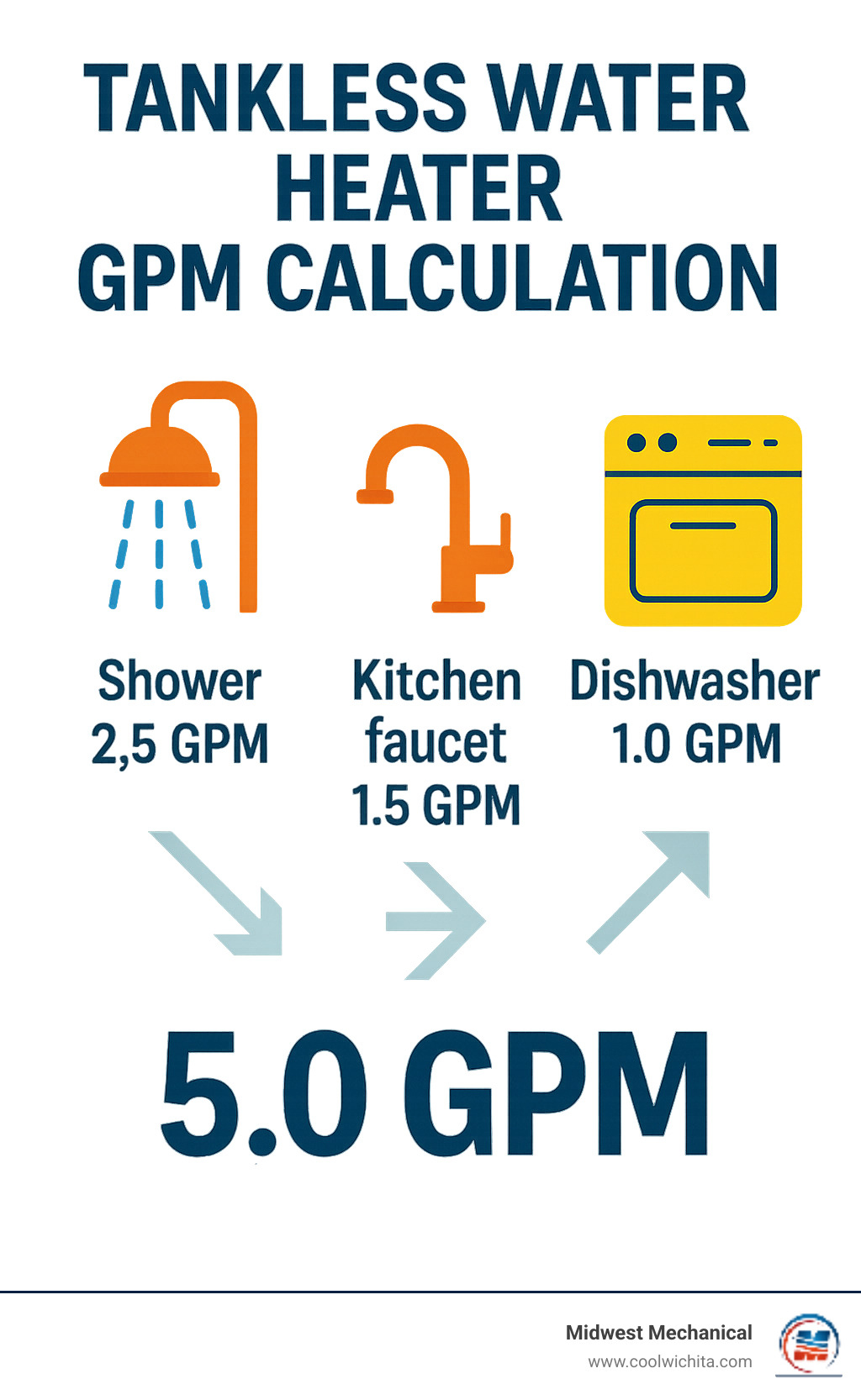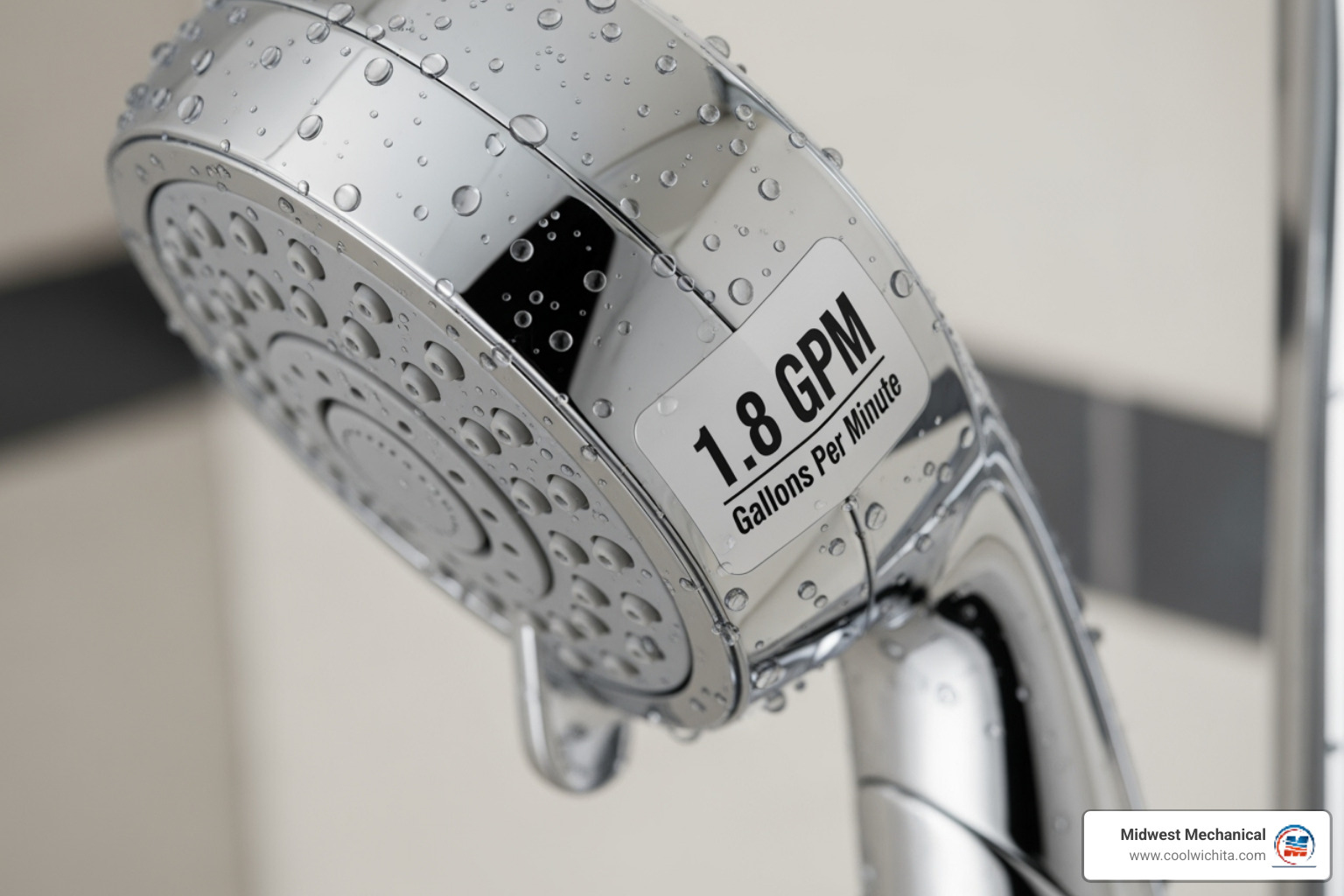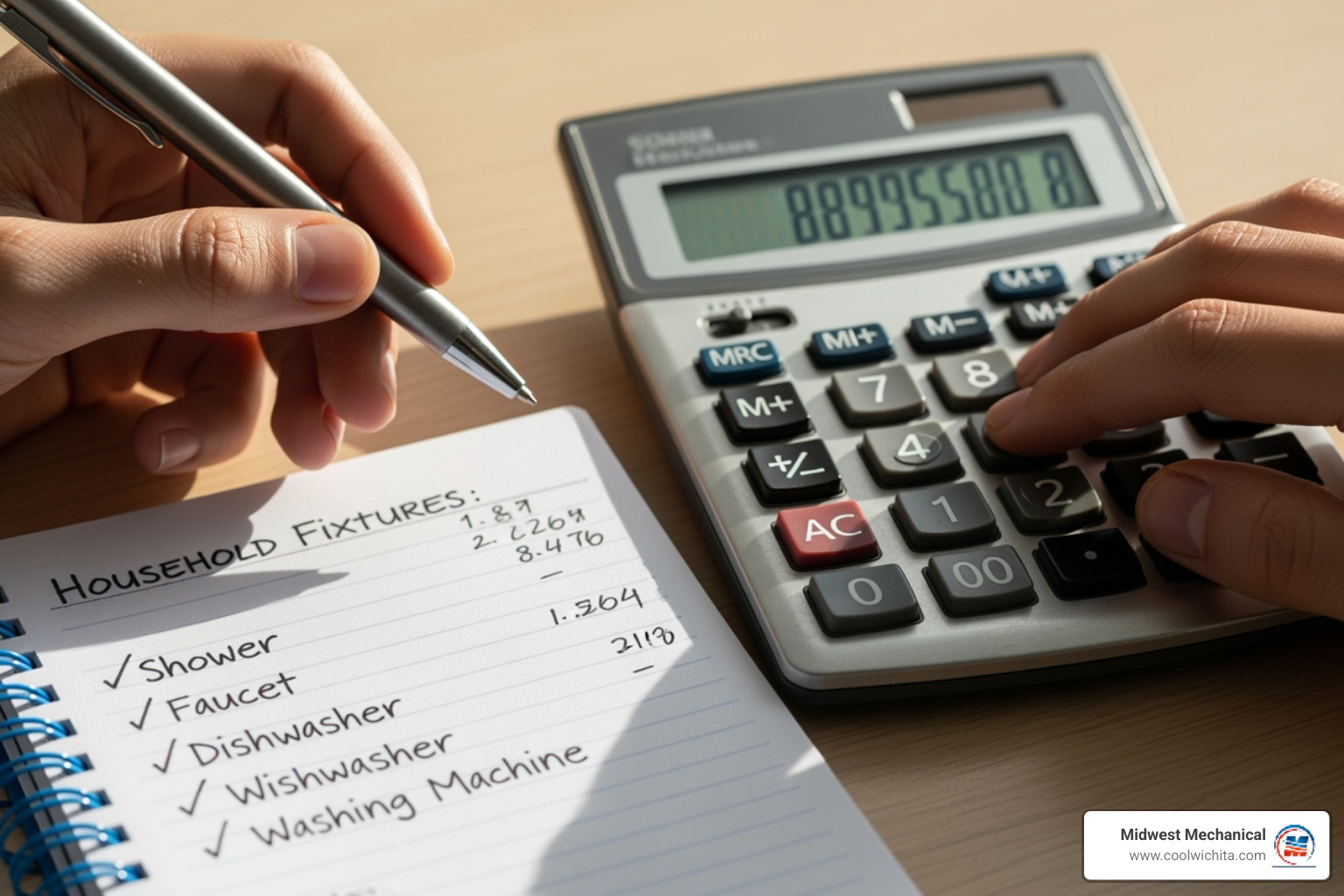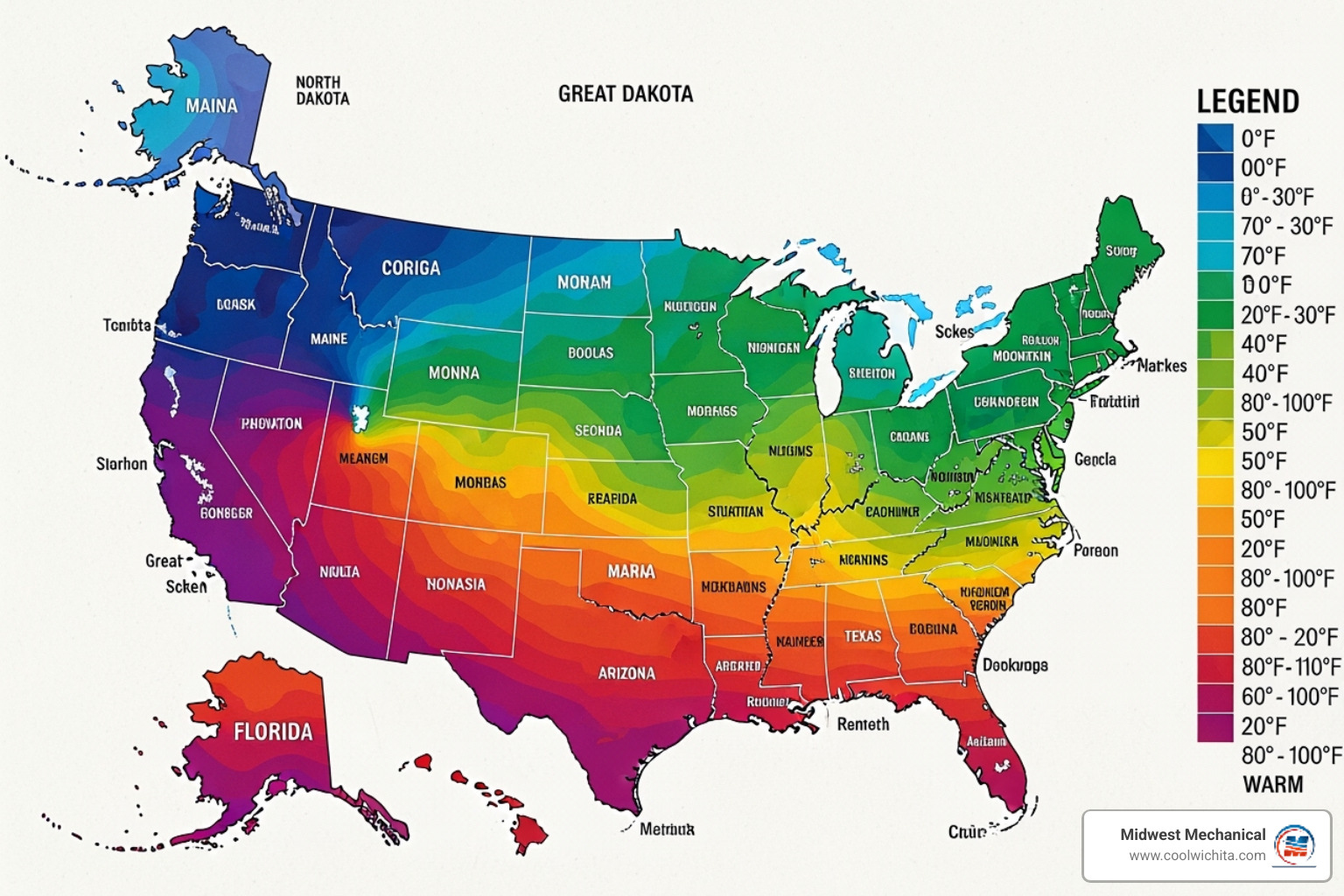Why Tankless Water Heater Flow Rate Determines Your Home's Hot Water Success
Tankless water heater flow rate is the key measurement that determines whether you'll have enough hot water when you need it most. Unlike traditional tank heaters that store hot water, tankless units heat water on-demand, making their gallons per minute (GPM) rating critical for your comfort.
Quick Answer: How to Determine Your Tankless Water Heater Flow Rate:
- Calculate Peak Demand - Add up the GPM of all fixtures you might use simultaneously
- Consider Temperature Rise - Factor in your local groundwater temperature (around 50-55°F in Kansas)
- Match Unit Capacity - Choose a heater that meets or exceeds your calculated GPM need
Typical Flow Rates by Fixture:
- Shower: 2.0-2.5 GPM
- Kitchen faucet: 1.0-2.0 GPM
- Dishwasher: 1.0-1.5 GPM
- Washing machine: 1.5-2.0 GPM
For most Wichita homes, a 7-9 GPM tankless unit handles daily needs like running a shower and dishwasher at the same time. However, getting the sizing wrong means either running out of hot water during peak times or overpaying for more capacity than you need.
The research shows that the average water heater should have a flow rate of at least 3.25 GPM, but your specific needs depend on your household size, usage patterns, and local climate conditions.

What is GPM and Why Does It Matter for Your Water Heater?
GPM stands for Gallons Per Minute, and it's the most important number you need to know when choosing a tankless water heater. Think of it as your water heater's "horsepower" – it tells you exactly how much hot water can flow through your system at any given moment.
Here's where tankless units shine differently than traditional storage tanks. While a regular water heater stores a big tank of hot water (say, 40 or 50 gallons), a tankless system heats water on-demand as it flows through. This means the tankless water heater flow rate determines whether you'll have enough hot water when everyone's getting ready for work in the morning.
Picture this: your teenager is taking their usual 20-minute shower, the dishwasher is running from last night's dinner, and you need to wash your hands. With a properly sized tankless unit, everyone gets hot water at a consistent temperature. But if your unit's GPM rating can't keep up with this simultaneous use, someone's getting a cold surprise!
The beauty of understanding GPM is that it helps you tap into all the Benefits of Tankless Water Heaters – endless hot water supply, better energy efficiency, and no more "honey, did you use all the hot water?" conversations.
Understanding Your Home's Peak Tankless Water Heater Flow Rate
Your home's peak demand is like rush hour for your water heater – it's when everyone needs hot water at exactly the same time. We've all been there: the morning scramble when someone's showering, the coffee maker is running, and the dishwasher decides to kick on.
This is where household habits really matter. A couple who works different shifts might never hit their peak demand, while a family with multiple bathrooms and teenagers could have hot water needs that spike dramatically during those busy morning and evening routines.
Let's get practical about calculating total need. If your family typically runs a shower (2.5 GPM) while the dishwasher is going (1.5 GPM), you're looking at 4 GPM minimum. Add someone washing hands in another bathroom (1 GPM), and you're up to 5 GPM for your peak demand.
The key is planning for that worst-case scenario – not because you're pessimistic, but because running out of hot water when you need it most is just plain frustrating. Getting this calculation right means your tankless unit will handle whatever your family throws at it, keeping everyone comfortable and happy.
For more detailed guidance on getting this sizing perfect, check out our Tips for Choosing the Right Water Heater Size.
How to Find the GPM for Your Fixtures
Finding the GPM for your fixtures is easier than you might think, and it's absolutely essential for calculating your tankless water heater flow rate needs accurately.
Start by checking your fixtures themselves. Many modern showerheads and faucets have their GPM rating printed right on a label or stamped into the device. Look for numbers like "2.5 GPM" or "1.8 GPM" – they're usually there if you know where to look.

Can't find it on the fixture? Check the manufacturer specifications or dig up those user manuals you hopefully didn't throw away. For appliances like dishwashers and washing machines, the manual will list exactly how much hot water they need.
If you're still stuck, try the simple bucket test method. Grab a one-gallon container and a timer. Turn on the hot water to your normal flow, fill the bucket, and time it. Then divide 60 by the seconds it took – if it took 20 seconds, you've got 3 GPM.
That low-flow fixtures are becoming more common and can significantly reduce your overall GPM needs. Here's what you can typically expect from common household fixtures:
Shower: 2.0 - 2.5 GPM | Kitchen Faucet: 1.0 - 2.0 GPM | Bathroom Faucet: 0.5 - 1.5 GPM | Dishwasher: 1.0 - 1.5 GPM | Washing Machine: 1.5 - 2.0 GPM
These numbers give you a solid starting point for calculating exactly what size tankless water heater will keep your Wichita home running smoothly.
How to Calculate Your Required GPM in 2 Simple Steps
Ready to figure out the perfect tankless water heater flow rate for your home? This is where the rubber meets the road! Getting this calculation right means you'll never run out of hot water when you need it most, and you won't overpay for more capacity than necessary.

Think of this as creating a blueprint for your home's hot water needs. We're going to walk through two straightforward steps that will give you the confidence to choose the right unit for your family. The Department of Energy offers additional guidance on Sizing a New Water Heater if you want to dive deeper into the technical aspects.
Step 1: Determine Your Peak Hot Water Demand
Here's where we play detective with your family's hot water habits. We need to identify that magical moment when everyone in your house decides they need hot water at exactly the same time. You know the drill - someone's in the shower, the dishwasher is running, and your teenager decides it's the perfect time to wash their hands.
Start by thinking about your busiest hot water moments. For most families, this happens during the morning rush or evening cleanup time. Maybe it's when two people are showering while the washing machine is running and someone's doing dishes. Whatever your household's version of "hot water chaos" looks like, that's your peak demand scenario.
Let's work through a real example that might sound familiar. Picture this: two family members are showering simultaneously, the dishwasher is running from last night's dinner, and the washing machine is tackling a load of laundry. Here's how the math works out:
Your first shower uses 2.5 GPM, the second shower also needs 2.5 GPM, the dishwasher requires 1.5 GPM, and that washing machine demands 2.0 GPM. Add them all up: 2.5 + 2.5 + 1.5 + 2.0 = 8.5 GPM total.
This means you'd need a tankless water heater capable of delivering at least 8.5 GPM to keep everyone happy and warm. Most families find that a unit with 7-9 GPM capacity handles their daily needs beautifully, though larger households or those with multiple bathrooms might need to aim higher.
It's better to size slightly up than to find yourself shivering in a cold shower because you underestimated your needs. Think of it as insurance for your comfort! For more help navigating these decisions, check out our guide on Choosing the Right Water Heater for Your Home.
Step 2: Factor in Temperature Rise (ΔT)
Now comes the part that many people forget - and it's a big one! The temperature rise, or ΔT (that's Delta T if you want to sound fancy), is the difference between how cold your incoming water is and how hot you want it to be. This matters because your tankless water heater works harder when it has to heat really cold water, which means it can't deliver as many gallons per minute.
Here's the simple math: if you want your hot water at 120°F (perfect for most household uses), and your incoming cold water is 50°F during our Kansas winters, your heater needs to create a 70°F temperature rise. That's a lot of work for any water heater!

Living here in Wichita means dealing with some pretty chilly groundwater, especially in winter. While our friends in warmer climates might enjoy incoming water temperatures of 70-77°F, we're often working with water that's closer to 50°F or even colder. This climate reality means we need more robust units than someone in Arizona or Florida would need.
Here's why this matters for your tankless water heater flow rate: that same unit that delivers 8 GPM in warm weather might only manage 6 GPM when working with our colder Kansas water. It's like asking your car to work harder going uphill - it can do it, but it won't go as fast.
So when you're shopping for your tankless unit, make sure it can deliver your calculated GPM (remember our 8.5 GPM example?) at the temperature rise you'll actually experience. Don't just look at the maximum GPM rating - dig into the specifications to see what it can do with a 70°F temperature rise. This attention to detail is what separates a great hot water experience from a frustrating one.
Key Factors That Influence Your Tankless Water Heater Flow Rate
Getting the right tankless water heater flow rate isn't just about doing the math on GPM and temperature rise. Several other important factors come into play that can make or break your hot water experience. Think of it like buying a car – you wouldn't just look at the engine size without considering fuel type, climate conditions, and whether you actually need a pickup truck or a compact car.
The power source of your tankless unit, your local climate, and the delicate balance between undersizing and oversizing all play crucial roles in determining what will work best for your Wichita home. Understanding these factors helps ensure you get a system that delivers consistent performance year-round, not just on paper. For more insights on system performance, check out our guide on Energy Efficiency Ratings for Water Heaters.
The Connection Between Power (BTU/kW) and GPM
Here's where things get interesting: the "muscle" behind your tankless water heater directly determines how much hot water it can actually deliver. British Thermal Units (BTUs) for gas models and kilowatts (kW) for electric models aren't just technical jargon – they're the key to understanding your unit's real-world performance.
Gas heater power is measured in BTUs, and more BTUs mean more heating punch. A gas unit with higher BTU input can heat more water faster, which translates to higher GPM output at your desired temperature. For example, a robust gas unit might comfortably deliver 7 GPM with a 70°F temperature rise, while a lower-powered model might struggle to hit 4 GPM at the same temperature difference.
Electric heater power works similarly but uses kilowatts instead of BTUs. Here's the catch: electric units typically can't match the raw power of gas models. While they're often more compact and easier to install (no venting required!), they usually max out at 2-3 GPM for significant temperature rises. This makes them better suited for smaller households or point-of-use applications.
The bottom line? Higher power equals higher flow – it's that simple. If you're experiencing temperature drops when multiple fixtures run, your unit might not have enough power for your household's demand. Our article on how to Resolve Water Heater Fluctuations can help you troubleshoot these issues.
Consequences of an Incorrect Tankless Water Heater Flow Rate
Getting your tankless water heater flow rate wrong is like wearing the wrong shoe size – you'll definitely notice, and it won't be comfortable. Let's talk about what happens when things go sideways.
Undersizing issues are the most common and frustrating. Picture this: you're enjoying a nice hot shower when someone starts the dishwasher, and suddenly you're getting hit with the dreaded cold water sandwich – that shocking blast of cold water that makes you jump and possibly say words your mother wouldn't approve of. An undersized unit simply can't keep up with demand, leading to inconsistent temperatures that turn your daily routine into a game of hot water roulette.
When your unit is working overtime to meet demand, it's like running a marathon at sprint pace – something's got to give. You might find yourself unable to run multiple fixtures simultaneously, turning your home into a hot water scheduling nightmare where everyone has to take turns.
Oversizing issues might seem like a "better safe than sorry" approach, but they come with their own headaches. You'll face higher upfront costs for capacity you don't actually need, plus potentially more complex installation requirements. It's like buying a semi-truck when all you need is a pickup – sure, it'll haul your groceries, but at what cost?
Wasted energy can also be a concern with oversized units. While tankless heaters don't have the standby losses of traditional tanks, an oversized unit might cycle on and off more frequently for small demands, reducing overall efficiency.
The sweet spot is finding a unit that comfortably handles your peak demand without breaking the bank or your patience. If you're noticing warning signs like inconsistent water temperatures or unusual cycling, it might be time for a professional assessment. Learn more about the Signs Your Water Heater Needs Attention to stay ahead of potential problems.
Frequently Asked Questions about Tankless Water Heater GPM
When it comes to tankless water heater flow rate, we get a lot of questions from homeowners in the Wichita area. Let's tackle the most common ones to help you make the best decision for your home.
What is the typical GPM for a whole-house tankless water heater?
Most whole-house tankless units deliver between 5 to 10 GPM, but the sweet spot for most families is somewhere in the middle. Here in the Wichita area, we typically recommend units in the 7-9 GPM range for most homes. This gives you enough capacity to handle those busy morning routines when someone's showering while the dishwasher is running.
Why do we lean toward the higher end of that range? Our Kansas winters bring colder groundwater temperatures, which means your tankless unit has to work harder to heat that chilly water. A unit that might provide 8 GPM in warmer climates could drop to 6 GPM when dealing with our 50-degree winter groundwater. It's always better to have a little extra capacity than to run short during peak demand times.
How does a tankless water heater's GPM compare to a traditional tank heater?
This is like comparing apples to oranges – they work in completely different ways! A traditional tank water heater stores a specific amount of hot water (like 50 or 80 gallons) and has what's called a First Hour Rating (FHR). The FHR tells you how much hot water that tank can deliver in the first hour of heavy use.
A tankless unit, on the other hand, doesn't store any water at all. Instead, it's rated by its instantaneous flow rate – how many gallons per minute it can heat as water flows through it. Think of it this way: a tank heater is like having a full coffee pot ready to pour, while a tankless unit is like having a super-fast coffee maker that brews each cup on demand.
The beauty of tankless is that you get endless hot water, but you're limited by how much the unit can heat at any given moment. No more running out of hot water during long showers, but you do need to make sure your unit can handle all the fixtures you want to use at once.
Are there different GPM considerations for electric vs. gas models?
Absolutely, and this is a crucial consideration for Kansas homeowners. Gas tankless water heaters pack much more heating power with their higher BTU ratings. A typical gas unit might deliver 5 GPM at a 70°F temperature rise – perfect for our climate where we need that significant temperature boost in winter.
Electric models, while often easier to install since they don't need venting, typically max out at 2-3 GPM at the same temperature rise. They're fantastic for point-of-use applications, like under a kitchen sink, but they struggle to meet whole-house demands in colder climates like ours.
For larger households in the Wichita area, gas models are usually the way to go. They can handle multiple fixtures running simultaneously, even when dealing with cold incoming water. Electric units work best for smaller homes, apartments, or as supplemental heaters for specific areas of your home.
The bottom line? If you're looking for a whole-house solution in Kansas, gas tankless units typically offer the tankless water heater flow rate you'll need to keep everyone comfortable year-round.
Get the Perfect Flow Rate for Your Wichita Home
Getting your tankless water heater flow rate right isn't just about crunching numbers – it's about creating a home where everyone can enjoy hot water without compromise. Think of it as finding that perfect balance where your morning shower stays steamy even when the dishwasher kicks on downstairs.
Proper sizing is crucial for your family's comfort and your wallet. An accurately sized tankless unit delivers consistent hot water while operating at peak efficiency. This sweet spot means you're not overpaying for capacity you'll never use, but you're also not left shivering when demand peaks.
The beauty of getting this right lies in the long-term savings. A properly matched unit doesn't have to work overtime to meet your needs, which translates to lower energy bills month after month. Plus, when your tankless heater operates within its optimal range, it tends to last longer and need fewer repairs.
But here's the thing – every home is different. Your neighbor's 8 GPM unit might be perfect for their family of three, while your household of five might need something with more muscle. Factors like your home's layout, your family's habits, and even Kansas's chilly winter groundwater temperatures all play a role in determining what's right for you.
That's where a professional assessment makes all the difference. At Midwest Mechanical, we've been helping Wichita families find their perfect hot water solution for years. We know that a teenager's 20-minute shower combined with a load of laundry can quickly overwhelm an undersized unit. We also understand that our Kansas winters mean your tankless heater needs to work harder than units in warmer climates.
Our team brings years of HVAC and plumbing expertise to homes throughout Wichita and surrounding areas. We'll walk through your home, understand your family's routines, and calculate exactly what tankless water heater flow rate will keep everyone happy. Then we'll recommend units that balance performance with energy efficiency, all while staying within your budget.
The installation process is just as important as choosing the right unit. Our expert installation follows all local codes and manufacturer specifications, ensuring your new tankless heater performs exactly as intended. You can learn more about what to expect in our guide on Water Heater Installation Steps.
Don't let an undersized unit leave you in the cold, or waste money on more capacity than you need. Let us help you achieve the total home comfort you deserve, backed by traditional service and state-of-the-art systems.
For expert help selecting and installing the perfect tankless water heater for your home's needs, contact our team for professional service in the Wichita, KS area. Explore our water heater services today!
Customer Testimonials
Hear from satisfied customers who trust us for reliable HVAC and plumbing service across Wichita.






Plus, the technician, Lee was very professional, knowledgeable and informative.
We will definitely be doing business with them sometime again in the past.


I'm prompt to my appointment. Thank you Midwest Mechanical.









We have partnered with GoodLeap to offer flexible payment options for your project. GoodLeap uses a soft credit check until funding and the highest score from all 3 bureaus to see if you qualify. It also takes just a few minutes to get started.








.svg)